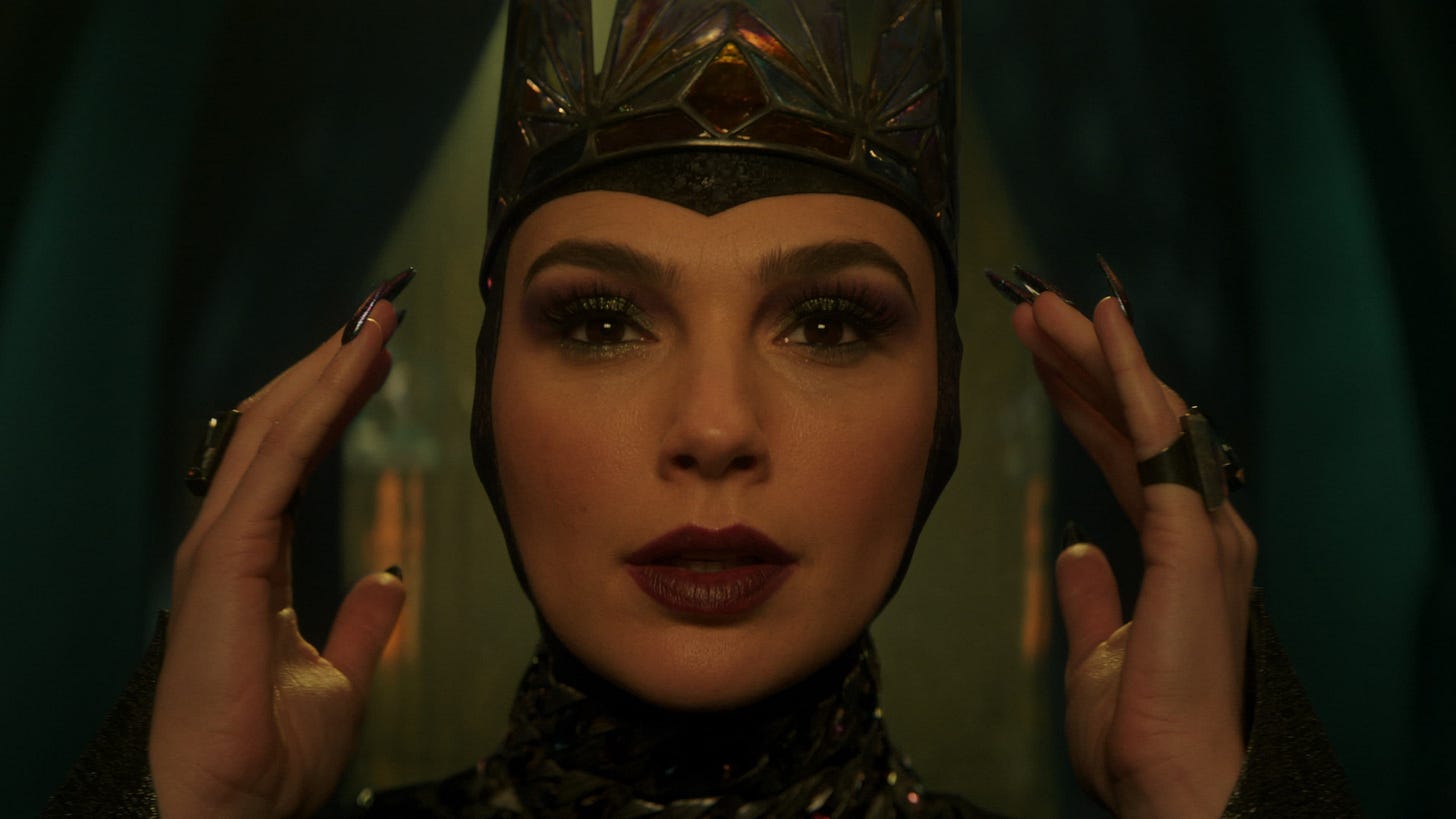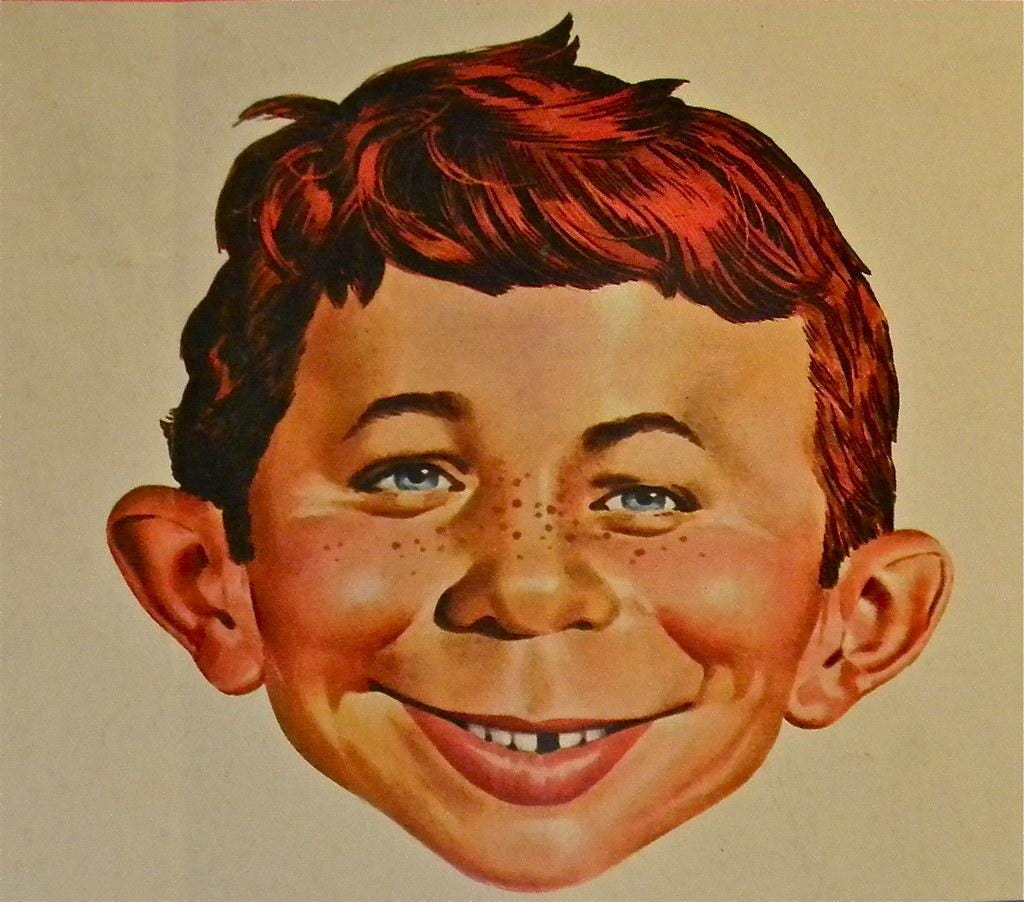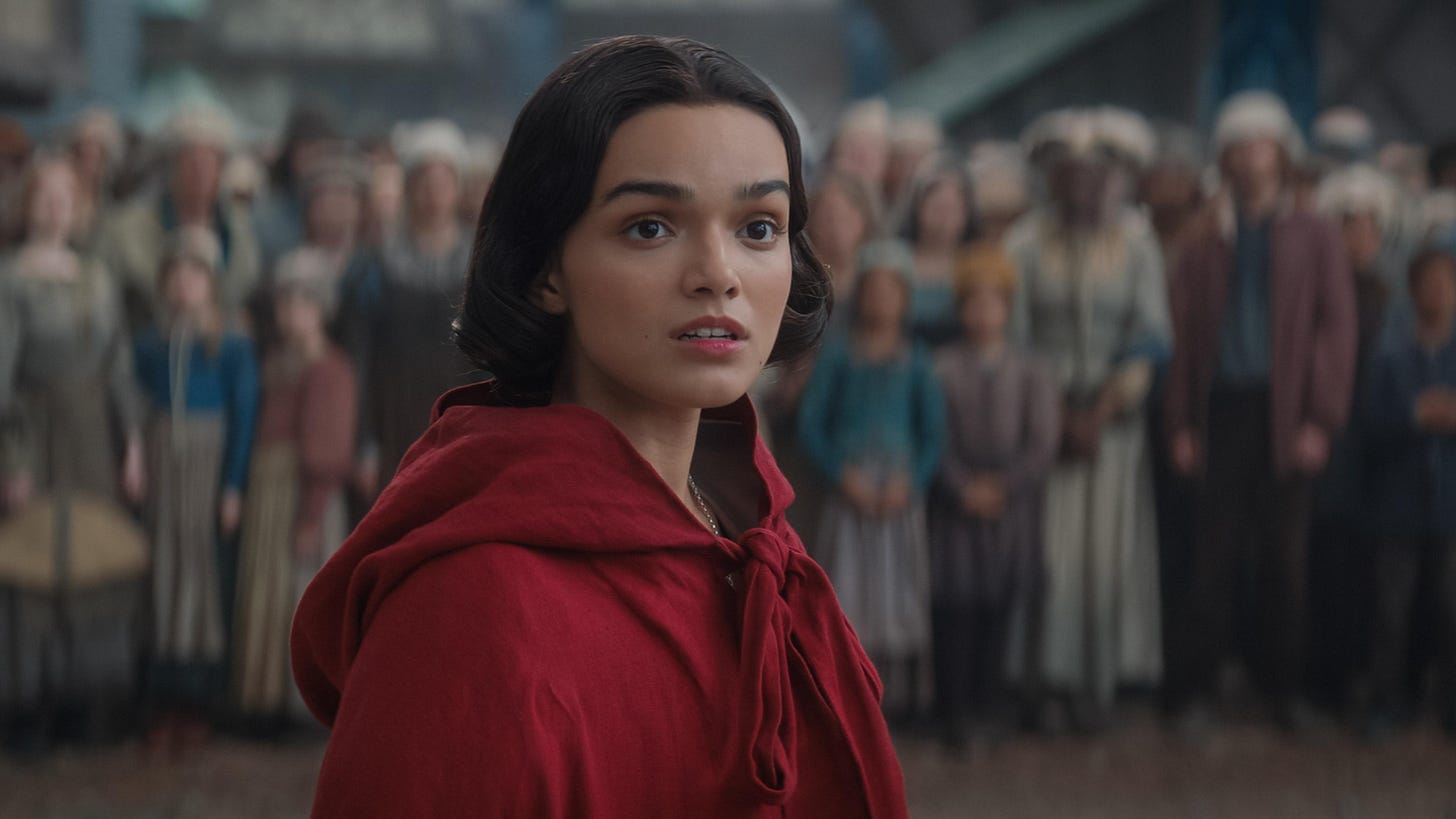Às vésperas do lançamento de Branca de Neve, as redes sociais trouxeram trechos que comprovariam a habilidade interpretativa e vocal de Gal Gadot e críticas positivas na esperança de que o barco fosse movimentado favoravelmente à refilmagem live-action do primeiro longa-metragem da Disney, lançado em 1937. Um artifício que a empresa já empregou anteriormente em lançamentos questionáveis da Marvel Studios, com fãs e influenciadores elogiando antes de o gênio deixar a lâmpada, e a opinião crítica bem como a pública mudaram consideravelmente. Não dava para antecipar, nunca dá!, que Branca de Neve seria desastroso e estabeleceria um patamar inferior nas refilmagens de clássicos animados do estúdios, mas havia indícios: os atrasos, a crítica do ator Peter Dinklage sobre a escalação de atores com nanismo para o papel dos anões, a escalação de Gal Gadot no papel da Rainha Má, atriz cujo alcance e talento são limitadíssimos.
Somente quem se salva desse desastre é a atriz Rachel Zegler, injustamente submetida a ofensas de quem criticou a escalação, em face da latinidade da atriz (como se Kirsten Stewart ou Lily Collins tivessem tido melhor sorte no mesmo papel). É justamente por causa da atriz, que tem a inocência e determinação necessárias para habitar o icônico figurino azul e amarelo da primeira princesa da Disney, que Branca de Neve não é uma experiência ainda pior. Apesar de Rachel ter sido deixada na mão pelo roteiro de Erin Cressida Wilson, que teve pinceladas de Greta Gerwig, ainda há sopro de vida quando entoa as canções com que tenta expressar o inconformismo emocional ou vivencia os desdobramento de uma história já conhecida, com direto ao Caçador, aos Anões ou ao beijo do amor verdadeiro. Aí iniciaram os (muitos) problemas de Branca de Neve: a sua incapacidade de adaptar, para 2025, o que funcionou em 1937.
Cerca de 9 décadas depois do lançamento do original, o espectador já é conhecedor de convenções ou clichês, e não que isso diminua o apelo do original, mas sim deste filme cujas alternativas para escapar de pontos sensíveis é bastante questionável. Um destes exemplos é Jonathan (Andrew Burnap), que faz as vezes do Príncipe Encantado e com o qual a Princesa cria um relacionamento amoroso, salvando-o em um momento para ser salva depois, a fim de superar estereótipos e até mesmo para que o beijo inevitável não seja condenável (spoilers, continua sendo!). Eu admiro a tentativa de atualização, é que quando percebemos que essas mudanças existem apenas para responder a críticas válidas, tudo parece artificial. Só não mais artificial do que são os Sete Anões.
Criados digitalmente, os Anões parecem habitar um vale da estranheza das animações de Robert Zemeckis, com contornos realistas costurados nos atributos exagerados. Por exemplo, Dunga parece ter sido a combinação do garoto da capa da revista Mad com o Smeagol (antes de achar o Um Anel e transformar-se no Gollum de Senhor dos Anéis). Dunga não é fofinho, é apenas assustador, e vê-lo “contracenando” com Rachel Zegler cria uma camada adicional de estranhamento que prejudica imensamente toda relação que eu tive com essas cenas. É até sintomático que a produção tenha escalado um ator com nanismo (George Appleby) para distingui-lo dos Anões e justificar o VFX.
A direção de arte de Kara Quinn é igualmente frustrante: com o orçamento estimado entre 240 e 270 milhões de dólares, um poderia esperar a imaginação e inventividade, não a mediocridade. O castelo, a ponte que o conecta à aldeia tipicamente medieval e a floresta sombria são desinteressantes, assim como são os figurinos de Sandy Powell: a Rainha Má passeia como diva, sonorizando os movimentos de mãos com os anéis e joias que traz consigo como se fosse Denzel Washington em Gladiador II. Por falar na vilã clássica, Gal Gadot tem uma expressão somente: um sorrisinho de canto de boca, que representa praticamente tudo o que a atriz deseja: a satisfação de ser a mais bela (ou “bela”), a maldade de quebrar a patinha do caranguejo para intimidar a enteada ou a inveja após o Espelho Mágico revelar o que não deseja escutar. Não ironicamente, a atriz é favorecida quando a Rainha Má transforma-se na Bruxa Má, pois a maquiagem mascara a sua inexpressividade.
Aí tenho que entrar no maior problema da atualização: a sua lógica interna. Quando a Rainha Má encara o Espelho Mágico, que reflete o que deseja escutar, pergunta: Who’s the fairest of them all. Apesar de a pergunta ter sido traduzida, em português, Quem é a mais bela de todas, fairest é justa, e não bela. Não há comparação de belezas, mas justiça e dignidade em como as personagens reais tratam os aldeões, o tema central narrativo. Eu me pergunto em que momento a Rainha Má tratou com humanidade seus súditos a fim de que o Espelho Mágico tenha antes considerado a personagem a mais justa/fair.
Incoerente, a discussão de como os governantes tratam os governados é infantilizada e resulta em um dos momentos mais risíveis da direção apática de Marc Webb: aquele em que conhecemos o tamanho do exército organizado pela Rainha Má para controlar a população conformada e esfomeada. Com uma quantidade de soldados que podemos contar com os dedos da mão - que poderia ser resolvida com os efeitos visuais -, Marc Webb revela em um plano geral o embaraço inteiro da direção. Um mais contundente do que quando constatamos que os poderes mágicos da Rainha Má servem para criar ilusões, flores e diamantes, e nada além disso. Que filme ruim, céus.
English review
On the eve of the release of Snow White, social media featured clips that would prove Gal Gadot's acting and vocal ability and positive reviews in the hope that the boat would be moved in favor of the live-action remake of Disney's first feature film, released in 1937. A trick that the company has previously used in questionable releases from Marvel Studios, with fans and influencers praising it before the genie left the bottle, and critical and public opinion changed considerably. It was impossible to foresee, it never is!, that Snow White would be disastrous and would set a lower standard in the remakes of the studio's animated classics, but there were signs: the delays, actor Peter Dinklage's criticism of the casting of actors with dwarfism for the roles of the dwarves, the casting of Gal Gadot in the role of the Evil Queen, an actress whose range and talent are extremely limited.
The only one who can be saved from this disaster is actress Rachel Zegler, who was unfairly subjected to insults from those who criticized the casting, given the actress's Latin origins (as if Kirsten Stewart or Lily Collins would have had better luck in the same role). It is precisely because of the actress, who has the innocence and determination needed to inhabit the iconic blue and yellow costume of Disney's first princess, that Snow White is not an even worse experience. Although Rachel was left in the lurch by Erin Cressida Wilson's script, which had touches of Greta Gerwig, there is still a breath of life when she sings the songs with which she tries to express her emotional nonconformity or experiences the unfolding of a well-known story, with direct references to the Huntsman, the Dwarves or true love's kiss. That is where Snow White's (many) problems began: its inability to adapt, for 2025, what worked in 1937.
About 9 decades after the release of the original, viewers are already familiar with conventions and clichés, and this does not diminish the appeal of the original, but rather of this film whose alternatives to avoid sensitive points are quite questionable. One such example is Jonathan (Andrew Burnap), who plays Prince Charming and with whom the Princess creates a romantic relationship, saving him at one point only to be saved later, in order to overcome stereotypes and even so that the inevitable kiss is not condemnable (spoilers, it still is!). I admire the attempt to update, but when we realize that these changes exist only to respond to valid criticism, everything seems artificial. Only no more artificial than the Seven Dwarfs.
Created digitally, the Dwarves seem to inhabit an uncanny valley from Robert Zemeckis' animations, with realistic contours stitched into exaggerated attributes. For example, Dopey looks like a combination of the boy from the cover of Mad magazine and Smeagol (before he found the One Ring and became Gollum from Lord of the Rings). Dopey is not cute, he is just scary, and seeing him "acting" with Rachel Zegler creates an additional layer of strangeness that greatly damages the relationship I had with these scenes. It is even symptomatic that the production cast an actor with dwarfism (George Appleby) to distinguish him from the Dwarves and justify the VFX.
Kara Quinn’s art direction is equally frustrating: with a budget estimated at between $240 and $270 million, one would expect imagination and inventiveness, not mediocrity. The castle, the bridge that connects it to the typically medieval village, and the dark forest are uninteresting, as are Sandy Powell’s costumes: the Evil Queen walks around like a diva, making her hand movements sound like Denzel Washington in Gladiator II. Speaking of the classic villain, Gal Gadot has only one expression: a smirk, which represents practically everything the actress wants: the satisfaction of being the most beautiful (or “beautiful”), the evil of breaking the crab’s leg to intimidate her stepdaughter, or the envy after the Magic Mirror reveals what she doesn’t want to hear. Not ironically, the actress is favored when the Evil Queen transforms into the Wicked Witch, because the makeup masks her inexpressiveness.
Here I have to address the biggest problem with the update: its internal logic. When the Evil Queen looks at the Magic Mirror, which reflects what she wants to hear, she asks: Who’s the fairest of them all. Fairest is not beauty. There is no comparison of beauties, but justice and dignity in how the royal characters treat the villagers, the central narrative theme. I wonder at what point the Evil Queen treated her subjects humanely so that the Magic Mirror would have previously considered her the fairest character.
Incoherent, the discussion of how rulers treat those they govern is childish and results in one of the most laughable moments of Marc Webb's apathetic direction: the one in which we learn the size of the army organized by the Evil Queen to control the conformist and hungry population. With a number of soldiers that we can count on the fingers of one hand - which could be solved with visual effects - Marc Webb reveals in a wide shot the entire embarrassment of the direction. One more striking than when we realize that the Evil Queen's magical powers serve to create illusions, flowers and diamonds, and nothing more. What a bad film.








A coisa tá feia para o mundo do entretenimento / cinema. Não há mais histórias originais sendo feitas e eles seguem tentar refazer clássicos, mas da pior forma possível. Sinto que a indústria ignora que o expectador não é mais o mesmo.
Excelente crítica!